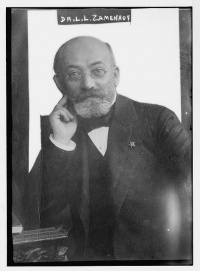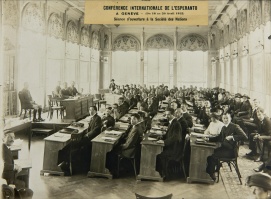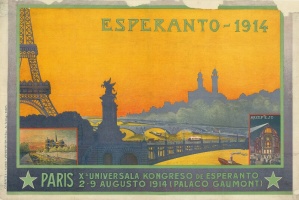Origin and Purpose↑
When the First World War broke out in 1914, Esperanto had already existed for twenty-seven years. The artificial language was created by Ludwik L. Zamenhof (1859-1917) with the aim of establishing a worldwide uniform means of communication that was both neutral and easy to learn. As an international auxiliary language, it was intended to help bring humanity together and secure peace. From the very beginning Esperanto was therefore based on a cosmopolitan idealism that was tantamount to a political programme. During the first world congresses between 1905 and 1907, when adherents met in Boulogne-sur-mer, Geneva and Cambridge, the interna ideo de Esperanto was explicitly formulated as the inner core of the new language: to create human brotherhood, justice and peace. However, due to the tense situation brought about by the Dreyfus affair in France, influential representatives of the movement pleaded their fellow Esperantists to behave neutrally in every respect. In order not to scare off potential supporters, the fact that Zamenhof was Jewish had to be concealed. Moreover, the intention was to emphasise to the public the practical benefits offered by a common language, rather than the cosmopolitan goal. It was believed that a wide dissemination of this linguistic tool would automatically have a unifying effect. That this approach could work is shown by the variety of associations, companies and individuals who began to use Esperanto on an international level at the beginning of the 20th century: Traders, scientists and lawyers, doctors and pharmacists, railwaymen, postal workers, policemen, Catholics, freemasons, socialists and pacifists. For everyone who was internationally active, it was of great interest to be able to communicate one’s thoughts and messages with just one language. Even using it in times of war was considered. In 1906, a guide was published for the Red Cross, providing soldiers, doctors and nurses around the world with a basic set of words and phrases. This was intended to enable both friend and foe to communicate on the battlefield or in the hospital.
During the First World War↑
The outbreak of the First World War was a severe setback for the Esperanto movement. After the assassination in Sarajevo the national borders were closed within a few days and exchange between citizens of different nations was abruptly put to a stop. The 10th Esperanto World Congress, which was to begin in Paris on 2 August 1914, was directly affected by this development. 3,739 participants had registered, over half of whom were coming from abroad. The congress, originally scheduled to last a week, ended after just one hour. The magazine Esperanto, the organ of the global association Universala Esperanto-Asocio (UEA), also had to temporarily cease publication. But this was not their main issue. Due to the flare-up of nationalism, many Esperantists were suddenly exposed to massive hostility in their home countries. This was because, in most countries, the national language was closely linked to national sentiment and Esperanto’s transnational approach inevitably aroused suspicion. Since the turn of the century there had been repeated warnings that the language undermined national sentiment. Against the backdrop of the war, this criticism intensified drastically. Due to their cosmopolitan aspirations, Esperantists were perceived in many places as potential traitors or even enemies.
Within the umbrella organisation, the UEA, they held their course despite all this and kept their sights firmly on the goal of international understanding. “We positioned ourselves above national borders, and above them we should remain in thought”, admonished chairman Hector Hodler (1887-1920) in 1915. He believed that after the war it would be up to the Esperantists to rebuild the world – a world of peace “engraved in the hearts of men”.[1] And the representatives of the UEA did not just talk, they also acted. Although only founded in 1908, by the start of the war the organisation had a wide-ranging network of confidants all over the world. Between 1914 and 1918 this network was used on behalf of private individuals to trace the whereabouts of missing persons and to establish contact with prisoners of war. Hodler deliberately made the existing infrastructure available to non-Esperantists as well; the general public was to benefit from the advantages Esperanto offered.
Within the local Esperanto associations, members found it more difficult not to be carried away by the flare-up of national sentiment. In anticipatory obedience, Esperantists in Germany, France, Italy and Russia put themselves at the service of their fatherland, taking the opportunity to prove their patriotism. The cosmopolitan usefulness of the auxiliary language was quickly reinterpreted. For instance, German pamphlets explained how English and French could be ousted by Esperanto whenever German itself could not be utilised. In Germany and France in particular, it was quickly recognised that Esperanto was excellently suited for conducting war propaganda abroad. The local Esperanto groups had extensive address lists and, thanks to the globality of the language, were able to carry out “educational work” worldwide. For example, Esperantists in Leipzig disseminated status reports of the German and Austrian army commands. The Dresden Esperanto Centre published a brochure, La vero pri la milito, which propagated the “truth about the war”, i.e. reproduced the rallies of Wilhelm II, German Emperor (1859-1941) and Chancellor Theobald von Bethmann Hollweg (1856-1921) as well as diplomatic correspondence. Starting in November 1914, the richly illustrated bimonthly Internacia Bulteno appeared and its issues continued until 1918. In the first issue the editors explained what they wanted to achieve: Firstly, to defend Germany against the spread of falsehoods and slander; secondly, to use the reach of Esperanto to serve the war effort; and thirdly, to prove that Esperanto was a living language.[2] In line with the usual propaganda, the magazine expressed through its articles and pictures where the roots of the war actually lay, what had really happened in the Belgian town of Leuven (Louvain), how benevolently the Germans treated French prisoners, and that art treasures were being protected and not stolen. In France, the committee Por Francujo, per Esperanto acted in a similar way. Through the Esperanto channels, it distributed well-targeted information material all over the world. Among other things, this included a government report from December 1914, which described all the violations of international law that the Germans had committed across almost fifty pages.
This approach quickly attracted criticism within the international Esperanto community – after all, the use of the auxiliary language for war propaganda purposes was completely at odds with the cosmopolitan spirit inherent to the project. Some internal critics argued that, because Esperantoland was transnational and had a common law of fraternity, it was necessary to be more neutral than the neutral states. But some of the national federations were not stopped by objections like these. Until the end of the war, the language and its network were therefore not only used for humanitarian missions and the spread of pacifism, but also instrumentalised for nationalist purposes.
Post-war Period↑
While the First World War was largely detrimental to the movement and its cause during the period of 1914 to 1918, the experience of war spurred the boom of Esperanto in the 1920s. A large number of books, magazines and newspapers were published in the artificial language. Schools around the world began to offer Esperanto as an optional subject. Over 4 million textbooks were in circulation by 1922. Not only did numerous chambers of commerce support the spread of the language, so did organisations as diverse as the International Committee of the Red Cross, the International Woman Suffrage Alliance, the International Institute of Bibliography and the International Federation of Hatters. Cities such as Madrid, Brunswick, Dresden, Edinburgh and Lisbon included Esperanto in police training to prepare their forces of order for tourism. At the same time, parts of the movement became politicised. For example, the Sennacieca Asocio Tutmonda (SAT), founded in 1921, acted as a rallying point for international workers and openly advocated for the abolition of all nations. The auxiliary language gained such importance that from 1921 to 1923 the League of Nations discussed recommending it as a school subject to its member states – a proposal that was ultimately rejected for various reasons. However, this did not dampen the boom that Esperanto experienced in the interwar period, especially as the League introduced it as langage en clair in telegraphy. It was only later, through National Socialism, Stalinism and the Second World War, that the spread of Esperanto was halted.
Malte König, Freie Universität Berlin (Gerda Henkel Stiftung)
Section Editor: Christoph Jahr
Notes
Selected Bibliography
- Alcalde, Javier: Pioneers of internationalism. Esperanto and the First World War, in: Walker, Julian / Declercq, Christophe (eds.): Multilingual Environments in the Great War, 2021, Bloomsbury Academic, pp. 44-57.
- Alcalde, Javier / Salguero, José (eds.): Antaŭ unu jarcento: la granda milito kaj Esperanto [A century ago. The great war and Esperanto], Paris 2018: Eldona Fako Kooperative de SAT.
- Brosch, Cyril / Fiedler, Sabine (eds.): Die Plansprachenbewegung rund um den Ersten Weltkrieg. Beiträge der 24. Jahrestagung der Gesellschaft für Interlinguistik e.V., 21.-23. November 2014 in Berlin, Berlin 2015: Gesellschaft für Interlinguistik e.V..
- Englert, Marine (ed.): Hector Hodler: une posture pacifiste / pacisma sinteno, Collection Hodleriana, Geneva 2020: Notari.
- König, Malte: Esperanto in der Zwischenkriegszeit. Ein kosmopolitisches Projekt auf dem Prüfstand, in: Historische Zeitschrift 314/1, 2022, pp. 68-104, doi:10.1515/hzhz-2022-0003.











